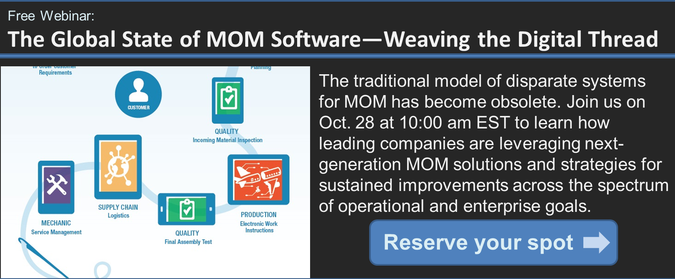So much has been written about the Industrial Internet of Things (IIoT) that separating the wheat from the chaff is becoming an ever more gargantuan task. The problem becomes more complicated by the fact that the IoT in consumer markets is hyped beyond comprehension. While the potential benefits are real, let’s not get ahead of ourselves in believing that the Internet of Things (IoT) will instantly solve all manufacturing and business problems across the world.
IoT Spans Everything
At LNS Research, we see potential benefits from the IIoT in all the manufacturing topics that we cover. One of the earliest beneficiaries of IIoT technology will clearly be asset performance management (APM). The ability to collect more information from smart connected assets about their own performance and the aggregated capabilities across many plants and sites is invaluable. It will transform plant and business performance through better preventative maintenance, performance balancing, and efficient use of assets.
Similar benefits will be seen in many manufacturing technologies, including Enterprise Quality Management Software (EQMS), Environment, Health and Safety (EHS), and Manufacturing Operations Management (MOM). The benefits that IoT technology can bring to MOM are huge, but in many cases there is a long way to go. Most MOM solutions are delivered as monolithic on premise solutions from a single vendor and are tightly integrated into the plant, but rather more loosely connected to business systems. As MOM solutions move towards groups of interlinked smart connected applications, we will start to benefit from the ability to deliver business processes built from the applications and others outside the MOM system–-the digital thread.
People, Process, Technology AND Data
Looking to the future, the data that is currently stored and displayed from the MOM system will become a vital part of every manufacturing company’s IoT Big Data repository. Indeed, we would argue that data will become as important as people, process, and technology in manufacturing. As data is shared across different business processes, and information from other systems and sources. The value of the data will continue to rise. This brings us to one of the fundamentals of moving towards more efficient business processes through the use of the IoT: collect data.
Control systems engineers tend to collect data from controllers and sensors that are useful to them for their immediate control needs. A little more is sometimes collected for APM purposes, and some for production reporting. A lot of information at the machine level is just ignored, which will change. You should consider making the change, as well. Data has value even if you don’t understand it, yet.
One area where data is already useful is in determining what has happened and, at the control level, why. These types of analytics are relatively common in MOM and in enterprise manufacturing intelligence (EMI) systems. While these are valuable, analytics that make use of big data from a multitude of sources open whole new avenues. Predictive analytics can start to tell me what will happen. Even more powerfully, prescriptive analytics can start to ask some truly useful questions such as “what should I do next?” or “how can I improve this process?”
Don’t Panic – You Will Get Help with Security
The IoT has a lot of followers (we are all jumping on the bandwagon), but there are naysayers. It serves up an opportunity for said naysayers to disseminate loads of FUD (fear, uncertainty, and doubt) in one subject: security. One simple question you can ask a colleague is which of the two following scenarios is likely to be more secure:
- Our plant that has three different versions of Windows running software that is up to 10 years old and with a network whose cabling is not even numbered. Bill, the guy who installed and maintained the network, retired last year.
- A multi-million dollar cloud platform that was built from the bottom up with brand new hardware, network and software and is kept up to date by an army of world class software and security experts.
With this question, we are not trying to abdicate responsibility for security but rather demonstrate that security has to be built in from hardware up. All major players in the IoT platform market are working tirelessly to ensure that security will be built into your IoT solutions from the smallest smart device to your Big Data analytics.
This blog post has reminded us that much of our business can be changed by the IoT. At LNS Research we always want to hear from our readers and clients about what they are doing in a particular field. In the coming weeks we will be launching an Internet of Things survey to find out how far down the path you are. Please keep a look out for it and take a few minutes to respond. We are sure you will find the results interesting and helpful in your IoT journey.